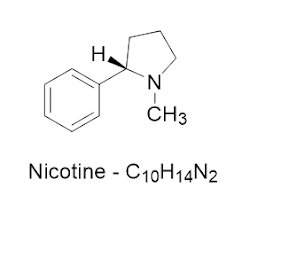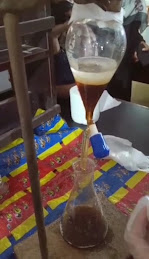Extraction
of caffeine from Coffee beans
Theory:
Caffeine is a natural alkaloid found in
coffee, and it is soluble in both water and organic solvents. The extraction of
caffeine from coffee beans involves the use of solvents to separate the
caffeine from the coffee grounds.
Materials:
- Coffee beans (100 grams)
- Distilled water (approximately 1 liter)
- dichloromethane (100 mL)
- Sodium carbonate (Na2CO3) (10 grams)
- Hydrochloric acid (HCl) (10 mL)
- Anhydrous sodium sulfate (Na2SO4) (a few grams)
Glassware
- Flask
- Funnel
- Filter paper
- Evaporating dish
- Hot plate
- Glass rod
- Mortar and pestle
Procedure:
- Grind 100 grams of coffee beans using a mortar and pestle to increase the surface area for extraction.
- Transfer the ground coffee to a beaker and add approximately 1 liter of distilled water to create a slurry.
- Add 10 grams of sodium carbonate to the beaker and stir the mixture well to dissolve the sodium carbonate. This creates an alkaline environment for extraction.
- Heat the beaker gently on a hot plate or Bunsen burner for about 15 minutes while stirring with a glass rod. This step is called extraction.
- After extraction, filter the mixture using a funnel and filter paper to separate the liquid (filtrate) from the solid coffee grounds. Collect the filtrate in another beaker.
- Transfer the filtrate to a separating funnel and add 100 mL of the organic solvent (e.g., dichloromethane or ethyl acetate).
- Carefully shake the separating funnel to allow the solvent and water to separate into two layers. After separation, remove the lower aqueous layer and discard it.
- Transfer the organic solvent layer (containing caffeine) to an evaporating dish.
- Add a small amount (a few grams) of anhydrous sodium sulfate to the evaporating dish to remove any remaining water.
- Evaporate the organic solvent using gentle heat to obtain a residue, which will contain caffeine.
- Weigh the evaporating dish with the residue to determine the mass of caffeine extracted.
- Perform calculations to determine the percentage of caffeine extracted by dividing the mass of caffeine obtained by 100 grams (initial mass of coffee beans) and multiplying by 100.
Step
1:
Calculate the amount of caffeine in the
extracted residue;
Amount of caffeine = Mass of extracted
residue * Concentration of caffeine
Amount of caffeine = X grams * 1% (0.01)
Amount of caffeine = 0.01X grams
Step
2:
Calculate the percentage yield;
Percentage yield = (Amount of caffeine /
Initial amount of coffee beans) * 100
Percentage yield = (0.01X grams / 100
grams) * 100
Percentage yield = 0.01X
Let's assume that after the extraction
and evaporation steps, you obtained a residue with a mass of 0.5 grams.
Substituting this value into the
equation:
Percentage yield = 0.01 * 0.5
Percentage yield = 0.005 * 100
Percentage yield = 0.5%
Therefore, the percentage yield of
caffeine extraction from coffee beans would be approximately 0.5%.
Observations:
Molecular Structure:
Molecular
Formula: C8H10N4O₂
Molar
Mass: 194.22 g/mol
Color:
Caffeine is a white crystalline soild.
Melting
Point: Caffeine has a melting point of 238-240°C
Boiling
Point: Caffeine has a boiling point of 178°C at normal
atmospheric pressure.
Precautions:
- Follow proper safety protocols when working with chemicals such as sodium carbonate, hydrochloric acid, and organic solvents.
- Use appropriate personal protective equipment, such as gloves and safety glasses.
- Ensure that the experiment is conducted in a well-ventilated area or under a fume hood to avoid inhalation of harmful fumes or vapors.
- Be cautious when working with heating sources and flammable solvents.
- Handle glassware carefully to avoid breakage or injury. Inspect glassware for cracks or damage before use.
- Dispose of chemicals, solvents, and waste materials according to local regulations and guidelines.
.PNG)







.PNG)
.PNG)
.PNG)


.jpg)
.jpg)
.jpg)
.jpeg)








.jpeg)



